TRIP REPORT: Ecuador – 2014 August – Andes & Amazon

TOUR FOCUS
TRIP LEADERS
PRIVATE TOUR OPTION
This tour is available as a private trip for any size group. The tour cost will vary with the number of people and any custom requests.
TESTIMONIALS
Trip report and photographs by Greg Miller
August 8-23, 2014
Ecuador is a small country (about the size of Colorado) located on South America’s Pacific Coast. Yet this bio-rich country has 60% more species of birds than occur in all of North America! And the hummingbird – Oh, my! Our group tallied more species of hummingbirds in 2 weeks (61 species) than have been recorded in Costa Rica for all time (53 species)! Amazing, isn’t it?
In 1998 I traveled over 130,000 miles and spent an entire year on a rigorous schedule to get 715 species of birds. 715. Our keen-eyed participants recorded nearly 600 species in Ecuador – in just 2 weeks…!
Yeah. Welcome to the magical experience that is Ecuador!
In 15 days we birded in cloud forests on both the eastern and western slopes of the Andes. We also traveled into the Andes high country which is inhabited by Ecuador’s National Bird – the Andean Condor.
The last part of our trip we ventured down the Napo River and spent several days birding in the rain forests of the Amazon Basin – the land of macaws, parrots, toucans, and so much more.
Day 1 – August 8, 2014 was the scheduled arrival date in Quito, Ecuador.
Day 2 – August 9, 2014
Reserva Yanacocha / Tandayapa Pass/Old Nono-Mindo Rd
70 species (60 seen; 10 heard only)

Reserva Yanacocha
Many of the team had no problem with travel getting to Ecuador. For 4 of us (including me), that was not the case. We were stuck in 2 different airports (Atlanta & Houston) overnight and did not get to Ecuador until late in the afternoon on Day 2.
Meanwhile, the rest of the folks got to see my #1 target for Ecuador – the Sword-billed Hummingbird. And they got to see scenery like this (right) at Reserva Yanacocha. Aargh!
I had to readjust my thinking and my expectations. Sometimes there are things that happen in life which we have no power to change. Time to be thankful for whatever time I can get in Ecuador and enjoy the experience. And I did. And I was not sorry.
Day 3 – August 10, 2014
Tandayapa Pass/Old Nono-Mindo Rd / Pacha Quindo Nature Refuge (Tony Nunnery’s yard) / Bellavista
Cloud Forest Lodge / Septimo Paraiso
103 species (90 seen; 13 heard only)
This was my very first full day of birding in Ecuador. Our first stop was wild and crazy with my first experience of a feeding flock of birds. There were big birds like the majestic Golden-headed Quetzal and tiny birds like the White-tailed Tyrannulet. And there were many tanagers, too, including Blue-gray Tanager, Beryl-spangled Tanager, and Fawn-breasted Tanager.
I saw my first of many Slate-throated Whitestarts. They are a little slate gray and yellow warbler that is called a slate-throated Redstart further north in Central America and Mexico where the yellow on the bird is actually orange. Its behavior was distinctly like that of our North American redstarts with tail movement side-to-side and then flashing white in the tail as it spreads.

Tanager Finch
I found it surprisingly difficult to follow all the birds in the flock. One tree might have so many birds that each birder in our group may be looking at a different species than anyone else simultaneously. The excitement and difficulty reminded me of a feeding flock of warblers in the May at Magee Marsh in Ohio. This was the first of many of these experiences to come.
The feeding flock phenomenon is also something that describes birding in much of Ecuador. The birds are not evenly distributed throughout the forests or edges. A birder can go for quite a while without seeing or hearing much of anything and then, BAM! It’s a feeding frenzy and 20 new species of birds! All within a short 10 minutes or so. It’s simply amazing.
Unfortunately, I didn’t have my camera out at the first stop. The next stop along the road I made sure I had my camera with me. And I was glad for that.
We didn’t have many birds further up the mountain. But we did have our first rarity – a Tanager Finch. Well is it a tanager? Or a finch? Umm. No one knows for sure. It is very unique, taxonomically. This bird was secretive and difficult to see. Some in our group could hear its high pitched song. I could not. But I was lucky. I not only got to see it. I got a photo of it (albeit a poor one – above left).

Distribution of Tanager Finch (from eBird)
One of the harder things to account for when birding in a new area is measuring rarity. If this was a first trip to Ecuador, almost everything is new. It is easy to put all the birds into the same mental category. But seeing a Tanager Finch on one’s first trip to Ecuador – just how rare is that?
Let’s look at eBird, a Citizen Science project where birders from around the world can submit their sightings to an online database (http://ebird.org), for a little help.
According to the bar graph data as of 9/15/2014 for the 2nd week of August, the percent of checklists submitted for all of Ecuador showing Tanager Finch is 0.39%. So the odds of seeing one randomly in Ecuador in August is about 1:260. While this is not a hard and fast number (because not everyone submits their sightings to eBird), it does give a rough estimate of rarity.
And how widely distributed is the Tanager Finch in Ecuador? Well, it is very, very local. In fact, according to the eBird distribution map, it appears that this bird is primarily Colombian, with one little spot in all of Ecuador. Check out the tiny little purple square near the “Q” in Quito on this map (eBird as of 9/15/2014 for all years—1900-2014 and all months).

Sparkling Violetear
We also stopped to view the hummingbird feeders in Tony Nunnery’s back yard (called Pacha Quindo Nature Refuge). We were served a delightful lunch while looking at a menagerie of hummingbirds.
The sheer number of hummingbird species here is dizzying. An average day might have 12-18 species of hummingbirds. Wow!
Our group recorded 18 species of hummingbirds for the day, and a majority of them were seen here.
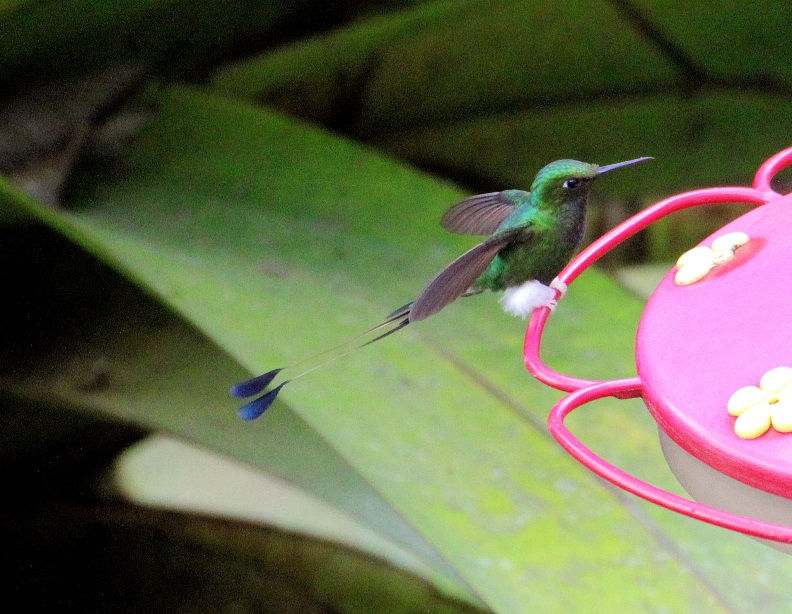
Booted Racket-tail
Day 4 – August 11, 2014
Refugio Paz del las Aves / Septimo Paraiso / Milpe Bird Sanctuary / Mindo–South Road
111 species (105 seen; 6 heard only)

Andean Cock-of-the-Rock
I woke up easily on this day, even though the hour was early. We were scheduled to drive to Refugio Paz del las Aves – the Antpitta Refuge.
But first on the agenda was being at an Andean Cock-of-the-Rock lek before dawn. We parked the bus and had a little snack before descending a fairly steep dirt path to a little blind. We were able to all scrunch in. All our lights were off. And even though it was still very dark we were instructed not to use any flash photography. The light scares the birds. Smoke-colored Pewees were calling everywhere around us, breaking the morning silence.
We didn’t have to wait too long until I heard the excited whisper of our local expert, Edison Buenaño, behind me. “Out to the right. About half way up.”
I looked in that direction and saw some branches and leaves moving. Then a flash of bright red. Then out of sight. A couple seconds later it popped into the open. Excitedly, I put my binoculars to my eyes. And there it was in all its splendor. My first ever Andean Cock-of-the-Rock. I was blown away! This bird was surreal.

Yellow-breasted Antpitta
We spent a couple hours watching the antics of several males trying to impress a female of the species. What a showy bird!
Next it was on to the antpittas. Angel and Rodrigo Paz feed several species of antipittas. Antpittas are generally very shy, secretive, and difficult to see. But the regularly scheduled feeding of these birds has made a few of them far easier to observe. Even so, not all the birds cooperate. And observers cannot use flash photography or flashlights. A few of the antipittas are very skittish and are easily scared.
After seeing a pair of Yellow-breasted Antpittas (left) near a stream at a lower elevation, we then began climbing a moderately steep trail. It had lots of steps. We climbed for about 40 minutes.
To this out of shape and overweight birder it was incredibly difficult. (For reference, it is roughly as steep as Scheelite Canyon in Southeastern Arizona for Spotted Owls.) I didn’t know if I was going to be able to complete the hike.
But I was happy that I did.

Dawn Smith with bean bag on her head to steady Tom Steller’s camera, and a Cloud-forest Pygmy Owl
On the way up there were other birds. Here is one of my favorites, a Cloud-forest Pygmy Owl (above). The owl was under a lot of leaves making the lighting dark and the photo more difficult. Some of the participants had an innovative solution (above).

Rufous-breasted Antthrush, Giant Antpitta, and Ochre-breasted Antpitta
Another good bird on the way was a Rufous-breasted Antthrush (above left).
And although the lighting was very dark for a photograph, it added to the mysteriousness of the shy and secretive Giant Antpitta (above center). Contrasting greatly in size, the tiny Ochre-breasted Antpitta was also present (above right).
We celebrated a good morning of birding with a homemade Ecuadorian brunch at this beautiful overlook. The food came in multiple courses. It was a delightful place.

Covered overlook at Refugio Paz del las Aves
Angel Paz placed some bananas in the nearby trees. The view from the building on the left in the picture above was a great vantage for photography. Here are a few good ones!
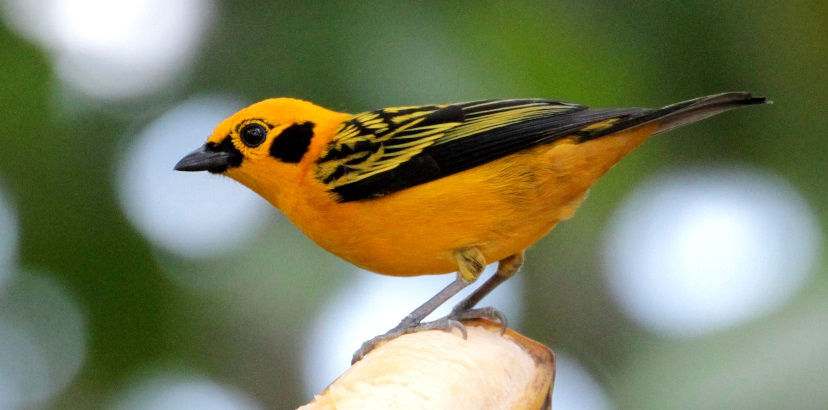
Golden Tanager
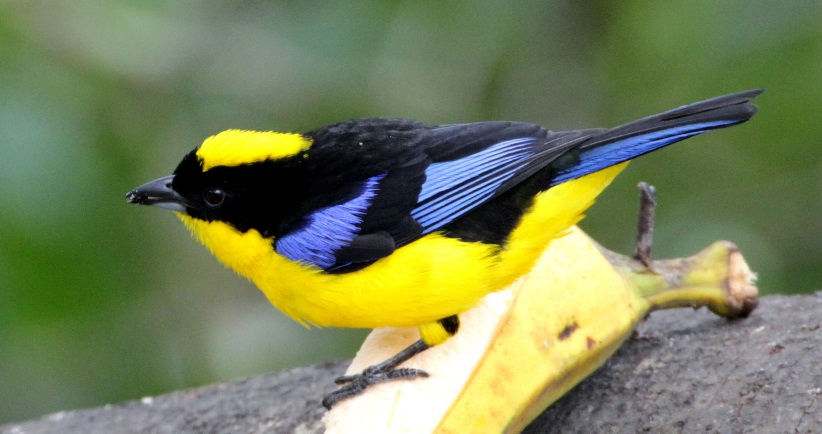
Blue-winged Mountain-Tanager
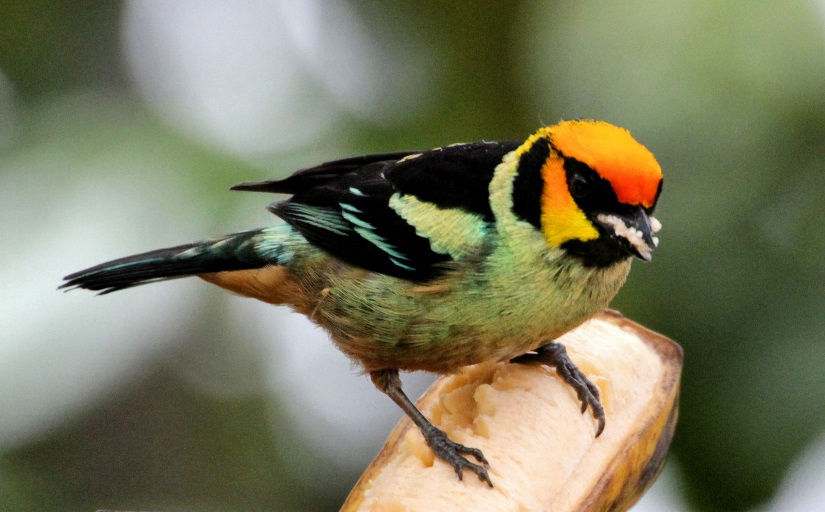
Flame-faced Tanager

Crowned Woodnymph
After the antpittas, we visited Milpe Bird Sanctuary. The feeders had tons of Green Thorntails. We saw our first Bananaquits here as well. It was a nice way to start our journey into Milpe.
The Crowned Woodnymph’s (formerly called Green-crowned Woodnymph; lumped again with Violet-crowned Woodnymph) colors were just absolutely stunning. The brilliant purple and cyan-like green together made these little hummingbirds like flying jewels.
But just down the path a little ways we heard some unique bird calls. Edison knew the calls right away. Pale-mandibled Aracaris!

A pair of Pale-mandibled Aracaris
My heart rate quickened. Aracaris are relatives of toucans. Toucan Sam on the box of the cereal Fruitloops must have had an effect on me as a kid.
And then we saw them! It was a pair of Pale-mandibled Aracaris. They came in close into the trees above the path we were on.
From underneath the bright red rump is not visible. These birds are really handsome and curious. The beaks were even more impressive than I had imagined. The beaks look solid and heavy. When the birds fly, it gives them the appearance of being front-heavy.
Day 5 – August 12, 2014
Mashpi–general area / Chontal–Oilbird Cave
69 species (63 seen; 6 heard only)

Septimo Paraiso Lodge
Those who have never taken a birding trip to Ecuador may think that we had to rough it with Third World accommodations. Haha! You would be vastly mistaken.
Here is the front of the first lodge we stayed in, Septimo Paraiso (or Seventh Heaven for those of us who do not know Spanish). This is more like a resort with outdoor pool and Jacuzzi, fountains, butterfly gardens, hummingbird feeders, and spacious, comfortable rooms.
And the food – Oh, my! We had delightful, multicourse meals. Fresh fruit juices were served with every meal. And their soups, and salads, and desserts that were well beyond my expectations. And check out the dining room!
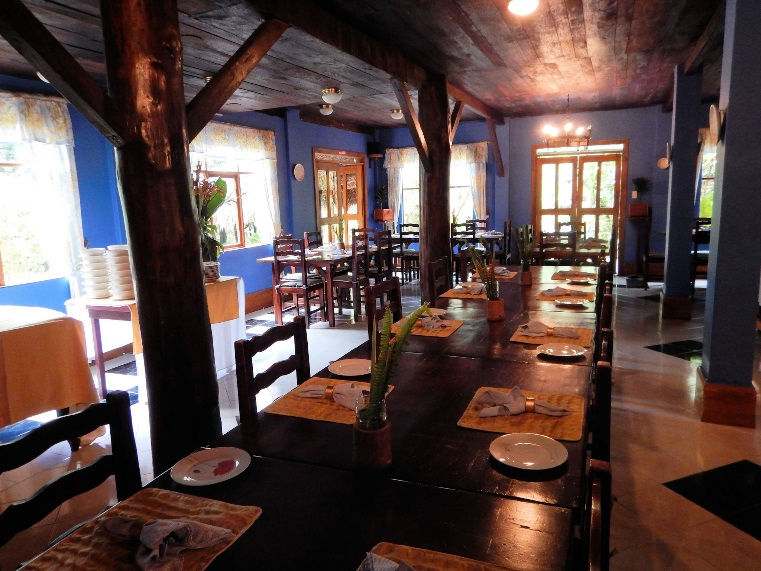
The dining room at Septimo Paraiso
Yeah. I know. Wow! It was here that I was introduced to a food item that was so good I had to ask what it was. Because I was certain that I wanted to never forget it. That item? It was a sauce called aji (pronounced AH-hee).
The people of Ecuador love their food. Some enjoy it mild, and some like it spicy. So the food is served mild, but you can add aji to spice it up. Each lodge had their own aji. In some places it was creamy and other places served it chunky like a salsa. Either way, aji was on the table for breakfast, lunch, and dinner. And I loved it. I put it on everything. On empanadas, rice, potatoes, plantains, breads, chicken, pork, and even in my soup.
We got another early start on day 5 and we drove up higher to Mashpi. It was quite foggy and it rained off and on for much of the day. But that added a mystical effect as the green mountains were enshrouded by fog. It was eerie, but beautiful.

Crimson-rumped Toucanet
I was really happy that we had a covered area from which to view the feeders in the rain. But I was even happier with the species of birds that frequented the feeders. An Empress Brilliant was dazzling but I got no good pictures in the difficult backlighting. Trough-like feeders had fresh bananas and Golden Tanagers, Golden-naped Tanagers, Lemon-rumped Tanagers, and Black-chinned Mountain-Tanagers. My biggest thrill for a feeder bird was a Crimson-rumped Toucanet (above). What a cool bird!
In the afternoon we went to see the reclusive Oilbirds—fascinating birds that roost in caves.
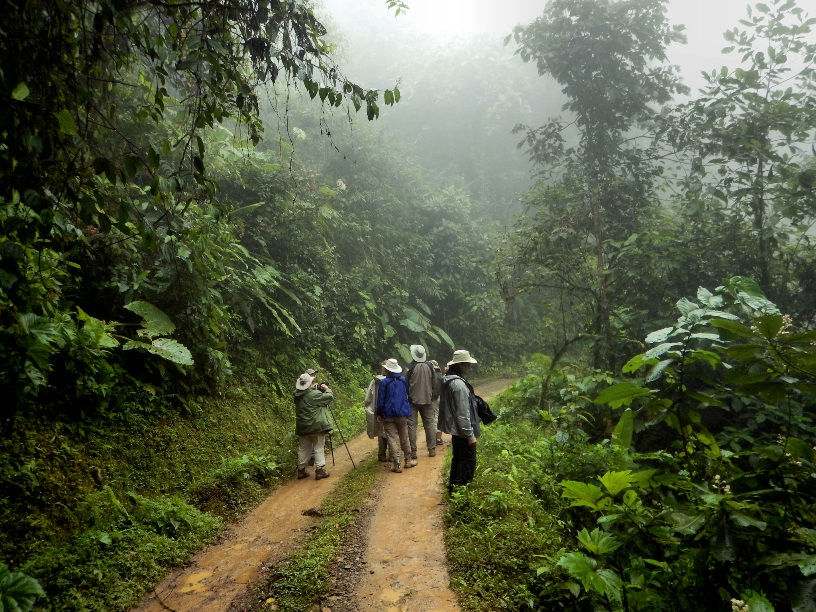
Birders in the fog at Mashpi
Day 6 – August 13, 2014
Quito General Area / Antisana Eco Reserve / Rt 28C / Guango Lodge
56 species (55 seen; 1 heard only)
We got up very early this morning and packed all our luggage on the bus. It was with a bit of sadness that I bid good-bye to Septimo Paraiso. It was such a lovely place. We left in the dark. Our goal today was to get through Quito, a sprawling city of about 2 million people. Thanks to our driver, Jorge, we wound through a complicated maze of streets to avoid the heaviest congestion. We made it out the east side of Quito with no issues.

Andean Condor showing off its 10-ft wingspan
I could feel my anticipation growing. The vegetation grew more sparsely as we climbed in elevation into the majestic Andes Mountains. The temperature was steadily dropping, too. All of us had brought layers of clothing in preparation. Our primary target was Andean Condor – a grand bird with the fifth largest wingspan of any bird in the World (only behind 4 species of albatrosses). It is the National Bird of Ecuador and rightly so. It is one very amazing bird.
We reached the roosting location. We scanned the rocky cliffs across the large open valley. Our timing was perfect. As we watched a couple condors perched, we got to see one of them take flight! It prompted Oooos and Ahhhs from us as we watched the spectacle. It’s not every day one gets to see an Andean Condor.
We had a total of 6 birds in the air at one time! Our keen-eyed group picked out a dozen condors on the ground feeding on a carcass. Wow!
By now we were at over 12,000 feet. A chilly wind was blowing and it started to rain. We traveled to several locations within the huge park. We visited a high elevation lake where we ticked a few new birds including Yellow-billed Pintail, Andean Duck, Andean Teal, Andean Coot, and Silvery Grebe. By now the combination of chill and rarified, thin air was getting to some of us. I found myself unable to do anything fast. And even the smallest grade of hill seemed difficult to manage.
The wide open areas were great for raptors. We had Variable Hawk, Black-chested Buzzard-Eagle, lots of Carunculated Caracaras and even an Aplomado Falcon. Tawny Antpittas entertained us near the buildings at the entrance to the lake. These birds didn’t act at all like their Ninja-like cousins which have great skill at hiding from birders. Andean Lapwings were plentiful in the grass along the road. Although we had to look for it, seeing an Andean Ibis was rewarding. Getting back on the warm bus became more and more appealing. And speaking of the bus – everyone had a window seat!

Everyone had a window seat on our bus!
By the time we reached the Guango Lodge it was raining heavily off and on. The cobblestone pathway led through a hummingbird paradise. There were little brightly colored gems at every feeder! Although the rooms were smaller than Septimo Paraiso, they were quite acceptable. The stone lodge has a quaint look to it. It reminded me of a hobbit home that one might see in the movie, Lord of the Rings.
Day 7 – August 14, 2014
Guango Lodge / Papallacta Pass and Vicinity
57 species (50 seen; 7 heard only)

Guango Lodge
I am starting to feel tired from all the activity. But the adrenaline is keeping me going. More fresh fruit juice with breakfast. Today I tried some of the thick, delicious, dark stuff they call coffee in Ecuador. I was anticipating the taste of this liquid. The aroma filled my nostrils as I filled my cup.
There was a clear glass pitcher next to the coffee with pure white viscose substance – roughly the consistency of Elmer’s Glue. I took note that 1) it must have a lot of cream, and 2) it sure was thick. I figured it must be really heavy cream. (Maybe I was more tired than I thought).
I poured it into the coffee and didn’t mix as well as I had hoped. Not to worry. It eventually dissolved completely. I added some of the light brown large granulated sugar. It tasted rich. It was quite good. Later, I found out I had added yogurt to my coffee. Oops!
I love Guango for the hummingbird feeders. I really cannot wait to go back. One can walk right out of the eating area and watch hummers from the porch. My number one most-wanted bird for this trip was about to make an appearance. It happened quickly, too. Half a dozen species of hummingbirds and then, BAM! The rockstar of birds appeared before us.

My life encounter with the Sword-billed Hummingbird
The Sword-billed Hummingbird. There. It. Was. It was jaw-dropping. It was a bigger hummingbird than I had imagined. And there is no way the book can portray the feeling one gets when you look at the length of the bill. I snapped a few photos not knowing if my hands were even still. I was a little numb I think. My eyes may have even moistened – I was so moved with emotion.
I really don’t have any adjectives that adequately describe this bird or the experience I had when I first saw it. It was a very soul-satisfying moment. Especially since I had missed this bird the first day. Others got to see it at Yanacocha. But I was one of the unlucky ones that had gotten stuck in airports and had our flights delayed.
What a relief. I felt like energy had leaked out of me. Had I been that wound up that I might miss this bird? Sigh. Maybe so. It sure felt like it now that the first encounter had occurred. While I was still reeling with emotion, Thee Creature of Extreme Awesomeness returned as if it knew the delight it would bring me. And it did.
There were many other stunning hummingbirds at Guango including Long-tailed Sylphs, Collared Incas, Buff-tailed and Chestnut-breasted Coronets, Tourmaline Sunangels, and more. And I loved the blue color of the many Masked Flowerpiercers.
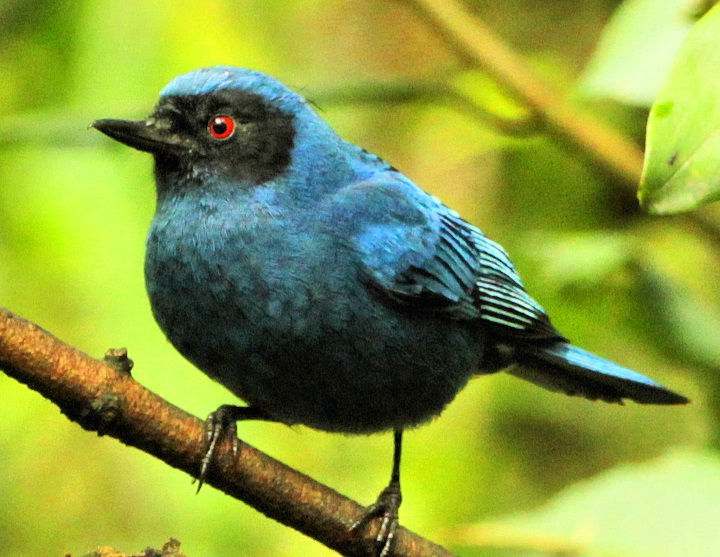
Masked Flowerpiercer
We hiked down to the river, but the river was roaring and full—too full for dippers or even Torrent Ducks. For me, the consolation prize was a good look at Roadside Hawk. It’s actually a pretty bird despite its rather pedestrian name.

Snow at Papallacta Pass
After our morning hike we drove up to high elevation again to Papallacta Pass. Our target was Rufous-bellied Seedsnipe, a very, camouflaged grouse-like bird.
It was raining when we left Guango. By the time we reached 12,000 feet the rain was visibly starting to change to white stuff—snow. Soon we could see that snow was starting to cover the ground. And by the time we reached the top at nearly 14,000 feet the road conditions had deteriorated considerably. And it was windy and very cold, even for this Ohio native.
Day 8 – August 15, 2014
San Isidro road / San Isidro-Sierrazul road
93 species (82 seen; 11 heard only)
By now I am starting to feel physically tired. But ooooh, the birds! By now the species were beginning to blur in my head. The plants, butterflies, and birds were altogether overwhelming to my senses. The lodges we stayed in were stunningly beautiful and the food was excellent. San Isidro was no exception. We stayed in spacious cabañas with terrific views. It’s nice to see lifers on the way to and from one’s cabin. The aji (bowls of hot sauce served with meals) was especially good here.
We started the day in a steady tropical rain. But, we didn’t have to worry about that. We stood under a covered area and watched birds come to us. One of the first birds was a magnificently colored Masked Trogon. It flew into a tree near us and perched in plain view as if to show off. Wow. Not to be outdone, several noisy Inca Jays landed in the tree directly in front of us. The combination of bright green, yellow, and blue on these birds is impressively gaudy and beautiful.

One of the hummingbird viewing areas at San Isidro
Near the parking area we were entertained with the presence of a Mountain Wren, a couple Pale-edged Flycatchers, and a Golden-crowned Flycatcher. I heard the beautiful descending song of the Black-billed Peppershrike. The song was slightly reminiscent of the Canyon Wren of North America. We all got looks of the bird, too. Just before boarding the bus we were treated to a Yellow-billed Cacique perched on top of a tree in a nearby valley.
We drove a short distance to Sierrazul Road. It rained off and on during our birding there. The feeding flocks of birds were pretty amazing. Each flock of birds was different. You might travel a bit without seeing or hearing much and then, BAM! A flock of several dozen birds is upon you. Everywhere you look there are birds. All of us could be looking at a single tree and each of us were on separate birds. There were trogons, woodpeckers, treerunners, tapaculos and antpittas calling, tyrannulets, flycatchers, wrens, euphonias, warblers, flowerpiercers, and, of course, many tanagers. And as quickly as they came, they left. What a rush!
Afterwards we headed back to San Isidro to watch hummingbirds. The hummingbirds of Ecuador are just fantastic. Here at San Isidro we were able to sit in chairs under a protected canopy and watch the little gems of the jungle.
Hummingbirds here at San Isidro included Tawny-bellied Hermit, Green and Sparkling Violetears,
Speckled Hummingbird, Fawn-breasted Brilliant, Buff-tailed Coronet, Bronzy and Collared Incas, Buffwinged Starfrontlet, Long-tailed Sylph, and the tiny Gorgeted Woodstar.
Day 9 – August 16, 2014
San Isidro road / Road to Sumaco / Loretto Road / Sumaco Rd
132 species (124 seen; 8 heard only)
Although this was a travel day, we stopped often enough to rack up a good list of birds. In fact, this was our birdiest day with a total species count of 132. Today we tallied 18 species of hummingbirds and 23 species of tanagers. In other words, about 1/3rd of all the birds we saw today were hummingbirds and tanagers. What is not to like about that!
We descended down the eastern slope of the Andes Mountains stopping at different elevations. This is part of the joy of birding in Ecuador – elevation change. You can drive a fairly short distance and see a strikingly different list of birds.
Today we encountered some misfortune. The bus had a flat tire and we had to stop to get it fixed. We were in a very small town. I’m not sure where we were exactly. But as it turns out, it was not disappointing at all (at least for us birders). We found a high point along the side of the road and racked up some pretty cool birds while waiting. Magpie Jays flying by were one of my favorite surprises. Oh, and there were multiple good looks at Chestnut-bellied Seedeater. And how about the Violaceous Jays and Spot-breasted Woodpecker? Yep. We didn’t mind waiting there at all.
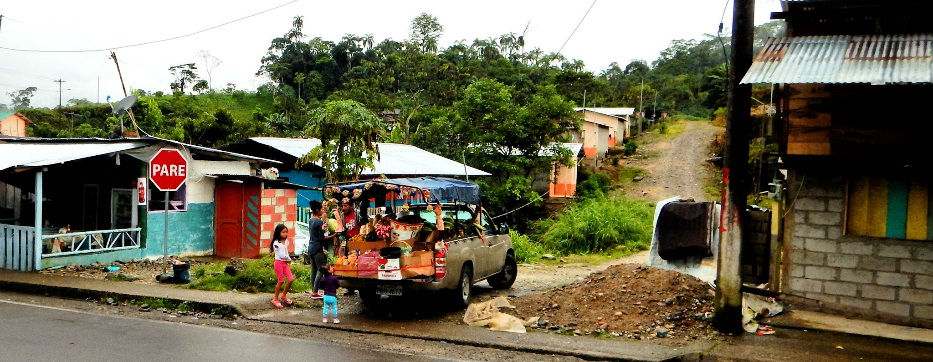
A produce truck in town where we stopped to get a flat tire fixed
Before we knew it we were on our way again. Time flies when you’re getting lifers! Along one of the roads we stopped and got out to look at a bird with a curious name, the Thrush-like Wren. It was also quite unique looking. And then a large dark bird flew over us. Holy smokes! Look at the huge bill! A Chestnut-eared Aracari, a toucan-like bird. Cool.
And then birding mayhem struck. Yes, a feeding flock. There were many tanagers. But one was blindingly spectacular – the Paradise Tanager. Whoa! That bird is so radically colored it does not even look real! Oh, my! Not to be outdone a Purple Honeycreeper made an appearance in the same tree. And in the same area were both Blue and Blackfaced Dacnis!
I think I may have just heard an angelic choir sing in my dream. Of course, it was all real. It’s Ecuador. Well. Except for the angelic choir. I just used that because I’m having a hard time describing birding euphoria, Ecuador-style.
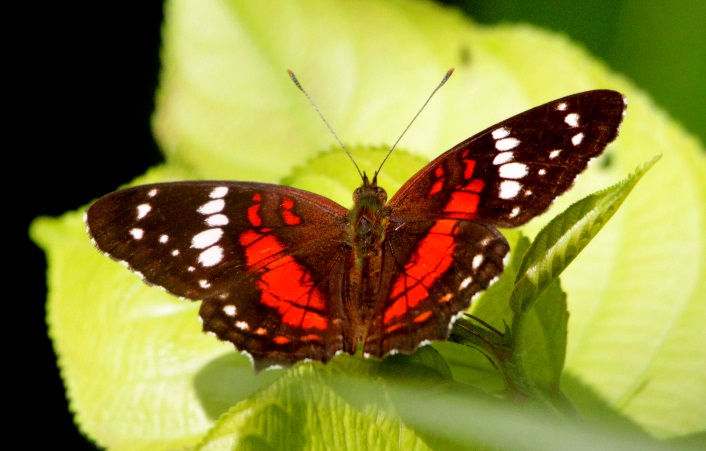
Scarlet peacock (or brown peacock) Anartia amathea

Wire-crested Thorntail
Wildsumaco Lodge is the lowest elevation we have been at so far on this tour. How low is it? 4900 ft. Yah. It is still in the mountains. But, it is the first place we have been where the temperature is markedly warmer. In the mountain lodges we had daytime highs around 70 degrees and nighttime temps in near 50 degrees. Upon our arrival at Wildsumaco the temperature was about 80 degrees. And the road to the lodge had butterflies – lots of them (above).
The most stunning thing about the road into Wildsumaco Lodge for me was the sighting of FIVE Paradise Tanagers in one tree! I still cannot get over the colors on this not-so-natural looking tanager.
The hummingbirds are different here, too. One of my favorites was the Napo Sabrewing (I don’t have any useable photos). And one of the more curious hummingbirds to me was the Wire-crested Thorntail (right).
Its wire-like sprigs sticking up like a crest on its head, its spiny tail feathers, and its plump pear-shaped body remind me of something that might have been created by Dr. Seuss.
Day 10 – August 17, 2014
Sumaco Rd
117 species (104 seen; 13 heard only)
Last night as the sun set behind the mountains, the view from the deck at Wildsumaco Lodge was
awesome!
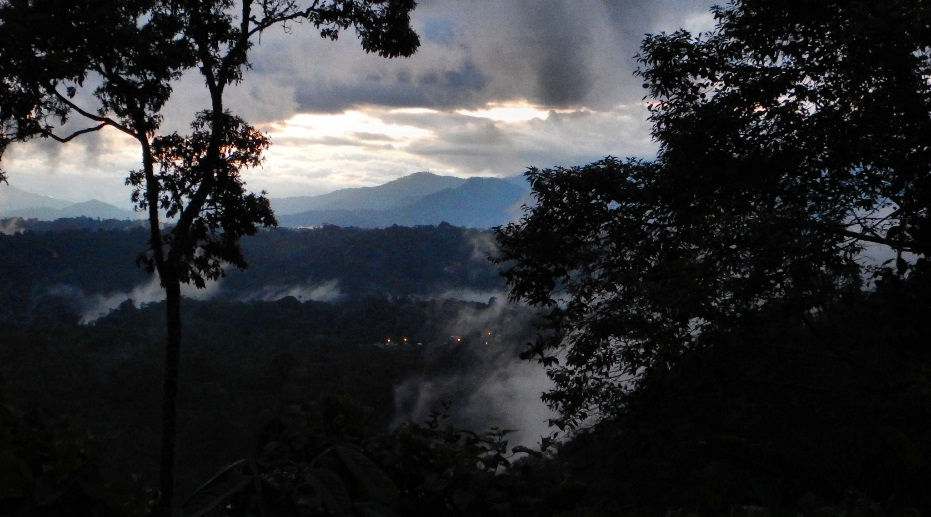
Dramatic view from the deck at Wildsumaco Lodge
The birds were amazing along Sumaco Road. We recorded more than 100 species again with many new birds for the trip.
One of the top highlights for me today happened on one of the trails we took off of Sumaco Road. We had hiked back into the jungle a ways and we all stopped and were told to be quiet. An owl had been relocated. We took turns hiking carefully up a steeper slope. A scope was set up and focused on a Band-bellied Owl. It was staring back at us. Thankfully, all of us got great looks. I enjoyed the quiet excitement I could see on everyone’s faces.
After the last of group came back down the slope we moved away from the owl’s location and birded our way back. But we didn’t get too far before I heard a sharp call. Our leader, Edison, recognized it right away. “Coppery-chested Jacamar!” he said excitedly.
I could feel my heart rate quicken. I love this family of elegant birds with shiny plumages and long, slender bills. They are mostly insectivores and many will hawk butterflies and moths out of the air from a favorite perch like flycatchers.
And this species’ status is Vulnerable. It is almost an Ecuadorean endemic, found only on the western slope of the Andes in southern Colombia, Ecuador, and northern Peru. We moved in the direction of the calls. The sound was closer and we stopped. My heart was pounding loudly. I remember staring hard in the direction of the sound. I did not want to miss this bird.
Thankfully, it didn’t take long to find the bird. What a stunner! And then I exhaled. What?!? I didn’t know how long I was holding my breath. We all got decent looks at the jacamar. First the owl. Now the jacamar. This place – Ecuador – I have no good adjectives to describe what a great experience this is!
In another area on a path we stopped on a forested hillside and waited and watched some bright flowers. This was favorite food of our target hummingbird, the White-tipped Sicklebill. Although the colors on this bird are rather drab compared to all the other birds we’ve been seeing, it more than makes up for its lack of color by its huge size and dramatically curved bill. Dramatic really doesn’t describe it. And many folks don’t use sickles anymore (even though that is an apt representation). It’s about as sharp a curve as a crescent moon. This bird was not as cooperative as it came swooping into view, hovered a moment, and then zipped off as quickly as it had appeared.
Out along Sumaco Road again a pair of strikingly-colored woodpeckers put on a display not far from our bus. Yellow-tufted Woodpeckers! They were clothed with a combination of black and white with bright yellow and fire engine red. Very handsome birds!

Sumaco Volcano
The birds continued to amaze me. But I was also aware we were birding within view of 13,000-foot Sumaco Volcano. It is one of more than 60 volcanoes in Ecuador, of which, about half are active. Sumaco Volcano is considered active although it last erupted in 1895. It sits well east of the rest of the Andes Mountains its lava has more alkaline content.
The mountain is highly forested and is part of the 66 square mile park, Sumaco Galeras National Park. The biodiversity here is maybe the best in the world, containing 6 climatic zones including tropical Amazon plains, Andean cloud forest, all the way up to páramo grasslands. Over 800 species of birds have been recorded in this park.
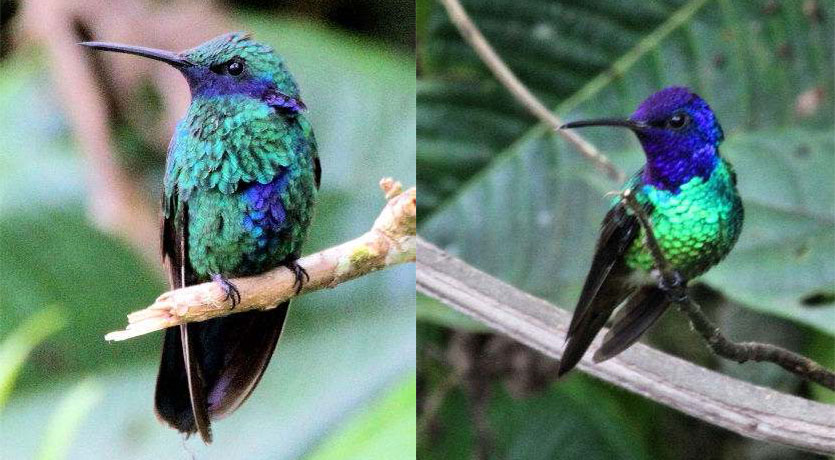
Sparkling Violet-ear, and Golden-tailed Sapphire
We had a total of 18 species of hummingbirds for the day. The hummingbirds of Ecuador are for me, one of the most charming aspects of the country. My favorite here was the Napo Sabrewing, a large green hummer with a brilliant, royal blue throat. It was magnificent!

Hummingbird viewing near Wildsumaco Lodge
Day 11 – August 18, 2014
Sumaco Rd / Loretto Road / Road to Coca (Rt 20) / Coca / Rio Napo
78 species (67 seen; 11 heard only)
 Just when I thought my senses could not possibly be more overwhelmed…BAM! Journey to the Amazon Basin. We left Wildsumaco Lodge at almost 5,000 feet and descended to the bustling little town of Coca at less than 300 feet elevation.
Just when I thought my senses could not possibly be more overwhelmed…BAM! Journey to the Amazon Basin. We left Wildsumaco Lodge at almost 5,000 feet and descended to the bustling little town of Coca at less than 300 feet elevation.
At Coca we left our comfortable bus and said our good-byes to our driver, Jorge. Jorge was a great driver and a real gentleman, too. We had lunch as we sat with our bags at the boat terminal. Finally our motorized, covered canoe arrived and we all boarded. It was actually a long boat that seated quite a few people, unlike the mental image you may get when I say “canoe”.
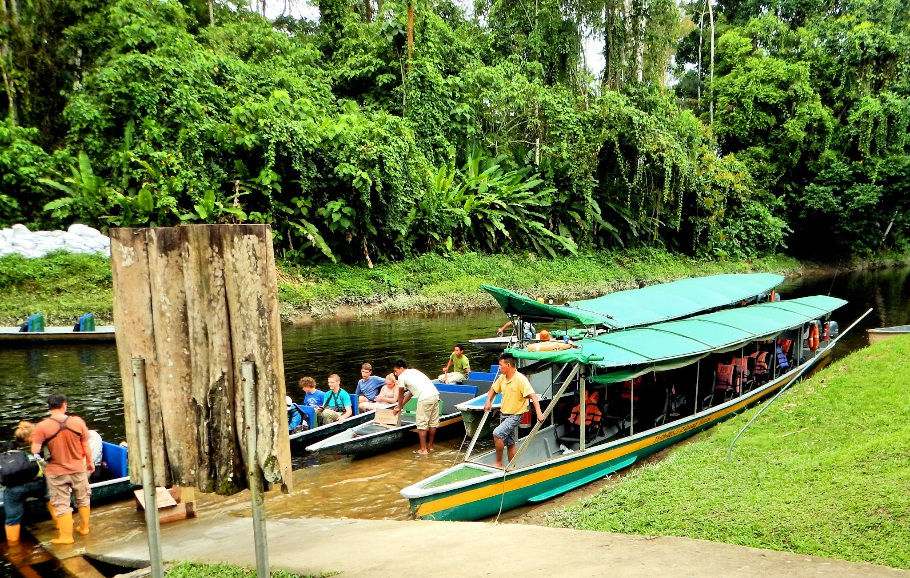
Transfer from covered, motorized canoe to a more traditional canoe
Day 12 – August 19, 2014
Napo Wildlife Center / Napo Wildlife Center side trail / Napo Wildlife Center–Añangu Creek
75 species (62 seen; 13 heard only)
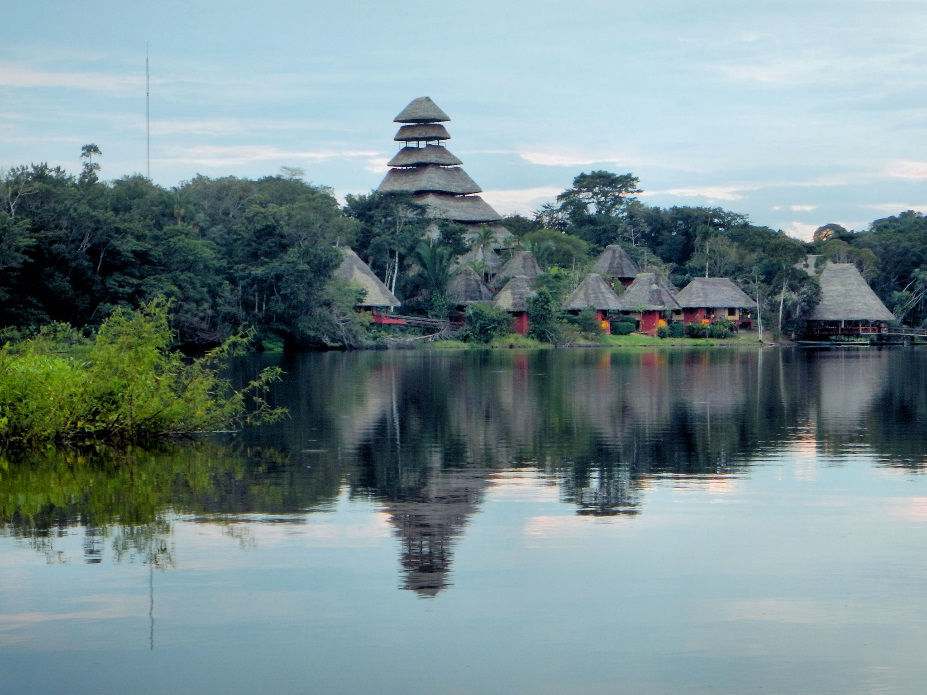
Napo Wildlife Center on Lake Añangu in the Amazon Basin of Ecuador

The front porch of cabin #6 (you can’t quite see the Striated Heron to the right)
When I saw this beautiful place I immediately dubbed it “Fantasy Island”. Yes. After the old TV show. And no, it is not an island. But it does look like a fantastically wild dream. And the food. And customer attention. I felt like I was pampered here. This is now one of my favorite places on earth.
And now, I bet you are wondering if this is just a good sales gimmick or do the birds come anywhere close to this jungle luxury? Haha. No need to worry. One could live in a hut here and be content with the magic of the birds. Toucans! Parrots! Macaws! Oh, my! Did I mention we saw monkeys? And a three-toed sloth? And giant otters? How about an anaconda? Yep, that, too. And there were not a few black caiman (crocodiles).

Black Caiman peeking above the surface of the water
Although I did not see any, there are allegedly piranha in the lake and swimming is discouraged. Swimming with piranhas, by the way, is not high on my list of things I want to do. Napo Wildlife Center is an otherworldly place. This would be our home in the Amazon Basin for three event-filled days.

Getting a lifer Red-capped Cardinal in the restaurant at Napo Wildlife Center
In the tropics, the birder must be prepared at all times. Really. I am not kidding. Like when you are eating a sumptuous meal at the open air restaurant at Napo Wildlife Center. We all got a lifer here. In the restaurant (yes, under the thatch roof flitting about – right). What was it? A Red-capped Cardinal!
Not all of the paths are broad in the area. In fact, sometimes we had to traverse some areas that were. Umm. Adventuresome. Ok. They were not dangerous. It’s just not what I am normally used to hiking. We all made it just fine with no issues at all. Crossing a log without the branch handrail might have been a bit more sporting.

One of the many hikes near Napo Wildlife Center
We canoed the waters of the Lake Añangu in the evening. Did I mention the giant otters? Yes. Yes, I did. This family of otters was very entertaining to watch. We had no lack of optics pointed their direction.
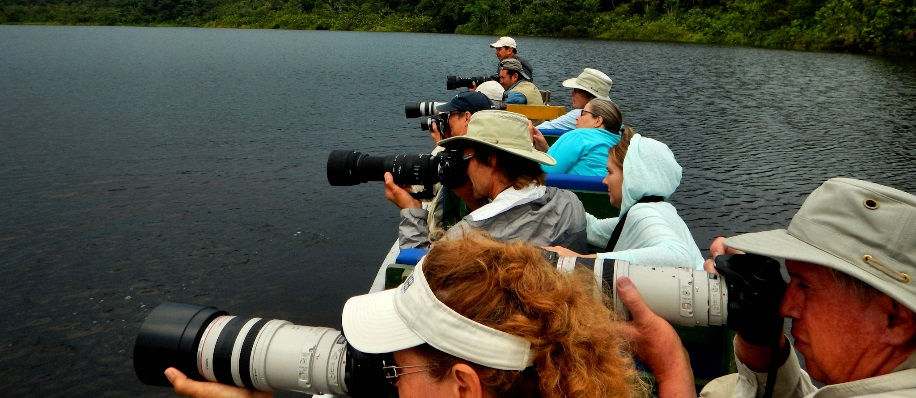
Giant Otter paparazzi
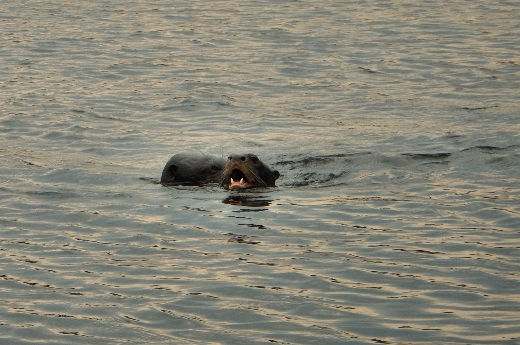
Giant Otters on Lake Añangu
After another most enjoyable canoe trip we returned to Napo Wildlife Center at dusk.
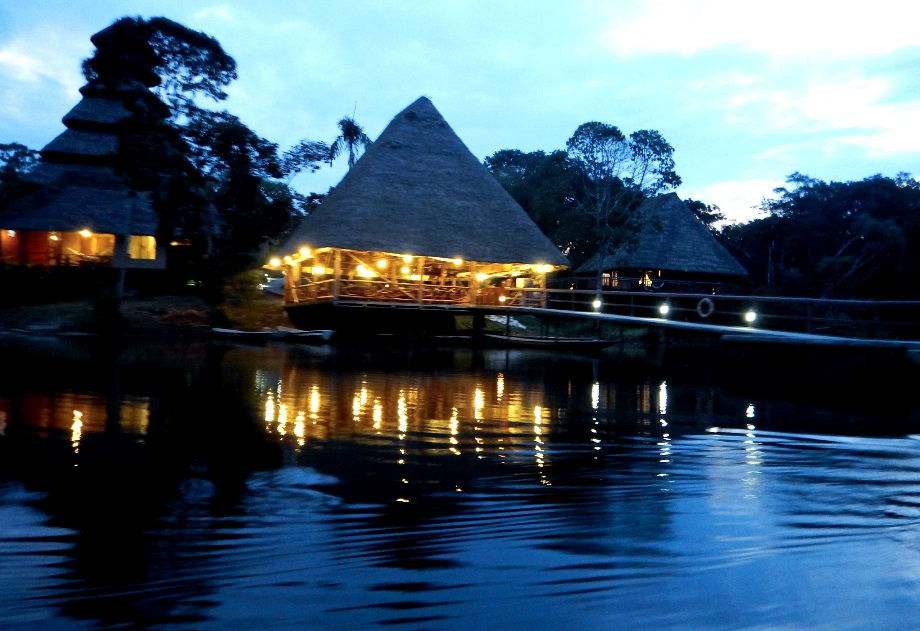
Napo Wildlife Center restaurant was beautiful in the evening
Day 13 – August 20, 2014
Napo Wildlife Center–Añangu Creek / Rio Napo / Rio Napo Island (Jorge)
105 species (87 seen; 18 heard only)
The alarm seemed to ring as soon as I had fallen asleep. Yes, we had to get up early so we could bird the Napo River in the early morning. We boarded the canoe in the dark by flashlight. Our guides paddled our canoe across the lake. The darkness in the Amazon Basin reminds one of just how much light pollution we have in North America. On Lake Añangu it was almost perfectly black. It was impossible to see even a few feet in front of oneself.
No breeze was blowing and the lake was quiet as we reached the mouth of Añangu Creek. Not long
after meandering through a few curves we came across the prize of the morning—a Zigzag Heron! It’s a small, medium gray heron with very fine markings. From a distance you might not think much of it. The tiny markings on each individual feather reminded me of the subtle beauty of a Gadwall here in North America. It looks like each feather was ornately etched—like an old time lithograph.
Thankfully our bird was perched on a branch that jutted out toward us. And it seemed almost tame. It was unobstructed by any branches and right out in the open. I shone my flashlight on the bird while others carefully photographed this gem. The status of this species is “near threatened” and it has a limited range. And even within that range it is not commonly seen. It was a bonus bird for us.
We continued into the darkness leaving the Zigzag Heron behind us. A couple more bends and curves and Hey! There is a Sungrebe! Although not nearly so rare as the heron, this species always ranks as a fun sighting to me. It is a pretty little bird in the water. But have you seen one perched so you can see the feet and legs? It looks like this bird got a pair of Dr. Seuss-inspired, striped, over-the-knee socks! I chuckled the first time I saw them. You might, too.

Picnic breakfast while birding along the Napo River
We arrived at the boat launch where we changed from paddle canoes to the motorized, covered canoes. We traveled upriver and beached on one of the islands in the middle of the wide, shallow waters of the Napo River. Just as we were boarding the island we got to see a large, dark form with very broad wings and a floppy flight. It landed in the top of a distant tree. An Amazonian Umbrellabird! Black Caracaras were perched across the other side of the river. Two Yellow-headed Caracaras flew by us while we were eating our picnic breakfasts. I added a number of lifers while eating breakfast.
We boarded the motorized, covered canoe again and headed downstream. We visited a couple
different clay licks—areas of clay from which parrots, parakeets, and macaws visit to eat dirt. Yes, they actually consume the clay! It is commonly thought that the clay neutralizes some of the toxins in the food that the birds eat. This may be true. But recent studies may indicate that the birds derive some benefit from the sodium content of the clay. Either way, it is a really cool experience to witness large groups of birds of a variety of species coming to the clay licks.

Clay lick viewing along Napo River
We saw several species of parrots, but my favorite was actually the most common—the Cobalt-winged Parakeets. They are small green birds with cobalt blue wings. The wings are very obvious when they fly—which they do often. These are birds that are very fidgety and always on the move. And they are amazingly entertaining to watch.
I had never seen a kettle of Swallow-tailed Kites until this day. It was about 30 birds wheeling in a loose group gently drifting in circles in the sky along the Napo River. These birds were just arriving at the end of August on their southbound journey. Could they have been birds from Florida? Maybe. It was a treat to see them.
Day 14 – August 21, 2014
Napo Wildlife Center–canopy tower & vicinity
112 species (90 seen; 22 heard only)
I do not know exactly what I had imagined about birding in the tropics. I guess I did not think about how dark the forest floor could be in the Amazon Basin. But the canopy made by large, thickly foliaged trees makes a great blanket over the unsuspecting birder. And many birds were high in the canopy. I would look up from the darkness at the canopy and the bright tropical sky was blindingly bright. Many birds were badly backlit. I gave a new color name to birds I’ve seen like this: Ecuadorian Black. But I must not have been the only birder to ever be bothered by such a thing. Enter the greatest invention for tropical birding—the canopy tower. These are tall structures built to put the observers above the canopy. The result? When you look down at a bird you see the thick canopy as background. It’s darker. And the bird’s true colors become as bright as flashing lights on a Christmas tree!

View from atop the canopy tower at Napo Wildlife Center
Napo Wildlife Center has a wonder canopy tower. It is over 100 feet tall and is well above almost all the trees except the giant sabo tree right beside it. The 208 steps (but who’s counting?) were daunting to this out-of-shape, overweight birder with an arthritic right knee. But how often do you get to go to Ecuador? And how many times do you get views from above the jungle canopy? I climbed the tower at a steady pace roughly akin to a banana slug. But when I reached the top the effort was all worthwhile.
The birding here ranked on just about the same surreal level as being on the movie set with Jack Black, Steve Martin, and Owen Wilson. It was a jaw-dropping unbelievable experience. Here are some of my favorite highlights of this dream: 4 species of aracaris, 2 species of toucans, 3 species of macaws (including Scarlet Macaw), 1 species of parakeets, and 3 species of parrots. Throw in a Crimson-crested Woodpecker, a neon blue colored Spangled Cotinga, a Bare-necked Fruitcrow, a Black-tailed Tityra, and a White-browed Purpletuft and, Wow! What a day! Wait, I forgot White Hawk, King Vulture, and Greater Yellow-headed Vulture! If you are ever in the tropics and you have a chance to get to the top of a tower, then by all means you should do it. It is a completely overwhelming experience!
Day 15 – August 22, 2014
Quito General Area
35 species (33 seen; 2 heard only)
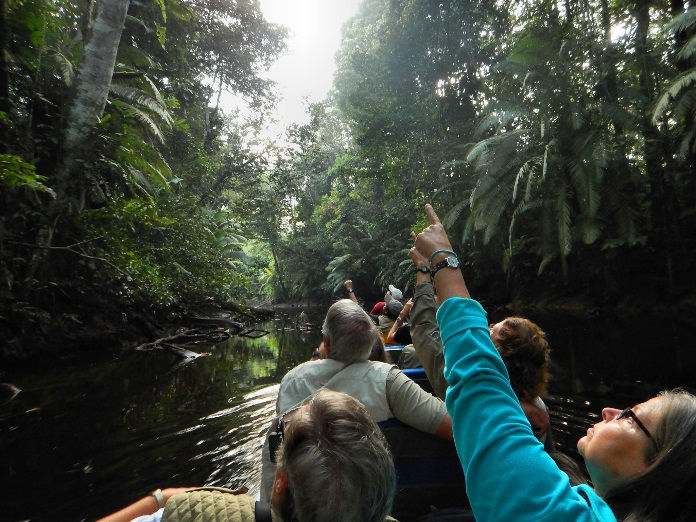
Birding along Añangu Creek on our way to the Napo River
Today was a travel day from Napo Wildlife Center and returning to Quito. This trip was much faster. Oh, we still had the 2 hours of paddling, then 2.5 hours of motorized, covered canoe to get to Coca.
But once we were at Coca we all boarded a plane to get us back to Quito.
It’s hard to believe all this was winding down. I was exhausted but elated. Traveling to the pinnacle of diversity in birding in the Western Hemisphere was more than I expected—and I had high expectations. It was truly the trip of a lifetime.
Day 16 – August 23, 2014
Departure – Quito
0 species

The plane that took us from Coca to Quito
Today we got shuttled back to the airport based upon our flight times departing Quito. For a few of who had evening red-eye flights our day was longer.
We hired Edison for one more day to return to the place – Yanacocha – that I had missed on the first day (since my flight from Atlanta to Quito was canceled). And we got to see my #1 target again: the stunning Sword-billed Hummingbird!
I am truly thankful to have such a wonderful local contact in Ecuador, Edison Buenaño. He is a talented birder, a good planner, a good trip leader, and a real gentleman. I really enjoyed birding with him.
I am also so very happy to been blessed with such a good group of participants. You all were quick to help each other both with the birds and with any other necessities. Having everyone look for birds was priceless. I am sure we saw more birds for all your combined efforts.
And finally I am truly grateful to Wildside Nature Tours for making this all possible. I sincerely hope you all enjoyed yourselves as much as I did. – Greg Miller




